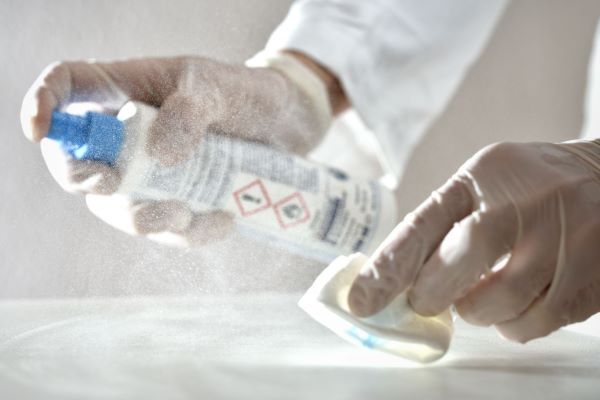Environment of Care – Clinical Findings
While doing tracers over the last year the consulting team is consistently finding the same issues in the clinical environment. Here are a few concerns that are commonly seen not only in the patient care areas but throughout organizations.
Compliance with Contact Times or Wet Times.
During mock surveys we always ask staff what the contact or wet time is for a particular disinfecting wipe. Unless they have changed products recently or are frequently getting different brands due to availability (a result of COVID-19) staff are able to verbalize the correct contact or wet time. The question is, do they know what it means? The answer to the question is NO!
Stated simply, the contact time, also known as the wet time, is the time period that a disinfectant needs to stay wet on a surface to ensure efficacy. Contact times for disinfectants range from 15 seconds to ten minutes, the maximum time allowed by the US Environmental Protections Agency (EPA). The contact or wet time is usually found on the front of the container or on the label. This time is determined by the manufacturer based on testing results using EPA approved methods and is the time period that staff must ensure compliance with.
In order for us to achieve an adequate level of disinfection, we also need to factor in the size of the wipe, the surface to be cleaned and at times longer required wet times. If the wipe is used on too large an area, then insufficient disinfectant may be applied, resulting in a failure to effectively decontaminate the surface. Allowing the disinfectant to dry before the required contact or wet time renders it ineffective. So, what do you need to do?
- Educate your staff on what a contact or wet time is and show them where to find the information on the disinfecting wipes container. Explain to them why this is so important. You might want to consider a competency for their file.
- Let staff know that if the disinfectant does dry on the surface before the contact time is reached, they need to reapply the disinfectant using a clean wipe to ensure that the contact or wet time is met.
- Monitor this process by observing staff to ensure that staff are following the steps for disinfection correctly and re-educate as often as needed.
- Continue to monitor the instructions for use (IFU’s) for the various surfaces being cleaned and select them when an option exists, choose the product with the shorter contact time. Be certain to seek the approval of your Infection Preventionist prior to switching products.
Remember, proper disinfection of surfaces saves lives!
Are your spill kits readily available?
When touring different areas of the hospital where blood is given, drawn, or tested and/or formalin is used for preserving specimens we ask to see the area's spill kit. To our surprise, many times a spill kit is not kept in that area. Accidents happen. Blood or chemical spills occur and need to be cleaned up; however, we need to do it safely. Where is your blood/chemical spill kit?
A spill kit contains a set of materials needed to control, contain, and clean up the blood or chemical spill. These kits need to be placed in areas that carry the risk of a potential blood or chemical spill, for example: in the nursing units, laboratory, operating room, and the warehouse, to name a few locations. They need to be readily available in the event of a spill. These kits typically contain the following items:
- Absorbent materials
- Something to contain the spill
- Something to handle the spill
- A disposal container
- Information for employees about what steps they should take in the event of an accidental spill
Depending on the type of kit you purchase personal protective equipment may or may not be contained in the kit. If it is not included be sure to have a gown, gloves, mask, and eye protection available to clean up the spill. Check your Safety Data Sheet for information on what type of kit is needed to clean up the spill.
Not having a spill kit for blood and/or chemicals will be a finding under the Environment of Care Standards related to managing the risks related to hazardous materials and waste.
Are those logs complete?
Logs are important when it comes to keeping track of temperature, humidity, crash cart checks, refrigerator temperatures, samples, etc. in different areas of the hospital. We always find it interesting that log checks are usually assigned to a staff member on a daily, weekly, or monthly basis, and yet we find that these logs are not always completed or completed properly. We have also noticed that when there is a variance from the normal ranges (temperature, humidity, etc.) there is no documentation as to what action was taken or a follow-up to the action. Missing information is also a common occurrence.
As the saying goes, “if it’s not documented, it’s not done.”
Failing to monitor the temperature in a refrigerator could cause medication or food to go bad. Not checking a crash cart can mean having an expired medication administered to a patient causing an adverse event or an essential piece of equipment missing from the cart. Failing to check that the samples are documented with all the required information can result in an adverse event if a sample product is recalled.
Even if completing logs seems like a mundane task, the results of not checking items and documenting findings can be dangerous. We must always think of our patient’s safety.
What about those grinders?
Finally, grinders. While surveying the Dental Labs and Podiatry Clinics primarily in the Outpatient setting, we see grinders being used. When walking into these areas surveyors look for eye and hearing protection. Grinders have the ability to spray pieces of plaster and plastic into the air and this can potentially cause these particles to end up in the provider/staff’s eyes. An easy fix is to wear goggles or a protective shield. Note: There is usually a label on the grinder that states that eye protection is advised.
It is also important to note that these grinders make a lot of noise. We recommend reading through the information for use (IFU) to see if hearing protection is recommended by the manufacturer.
In summary
The above issues are commonly seen in organizations but are easy to fix. It is important to take the time to educate staff on what a wet time is and what it means, purchase spill kits for areas that deal with blood and chemicals, follow up with log completion, and have the appropriate eye and hearing protection when utilizing the grinders. Patient and staff safety should be the top priority!
To learn more about common concerns and findings found in clinical areas of healthcare organizations and what you can do contact the C&A team at 704-573-4535 or email us at info@courtemanche-assocs.com.


